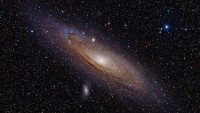13.1 Billion-year-old Galaxy Discovered; The Farthest Galaxy From Earth To Date
| Aishwarya Bhatt | | May 12, 2015 09:21 AM EDT |
(Photo : Reuters) The ring of stars circling Sagittarius A, the Milky Way's central black hole, shows a combination of infrared and X-ray observations indicating that a surplus of massive stars has formed from a large disk of gas around the black hole.
A team of astronomers from Yale University and University of California discovered a galaxy which is farther than any galaxy ever known to human beings. It is 13.1 billion years old and was discovered using the ancient star system. The discovery of this galaxy has awed the scientists and the public alike.
Like Us on Facebook
Published in "Astrophysical Journal," the identified galaxy is also one of the earliest formed galaxies in the history of the universe, since the occurrence of the big bang, states WGBH News. This discovery has broken the past records as well.
This galaxy now holds the record to be the farthest galaxy from the planet Earth, which is situated at such a far-off location as it continue to expand, even after it was fully created in its existing existential spasm. Named as EGS-zs8-1, it is estimated to be about 30 billion light years away from the planet Earth, states The Guardian.
Since this galaxy is situated billion years away, when the scientists look at it through the Hubble telescope, it appears like they are peeking into the past. Here is the explanation to this phenomenon. Light gets reflected off the moon in 1.3 seconds before it reaches Earth, and it takes up to 8 minutes for the light to get reflected off the surface of the Sun before it reaches Earth. Hence, for an object, which is present billions of light years away from us, it takes so much time for the light to travel back, that it appears like peeking in to the past.
This is helping the astronomers to see ancient and distant galaxies in their young formation; some of these galaxies are about one sixth of the Milky Way and are creating stars at a speed which are 80 times faster than the Milky Way.
Tagsgalaxy discovered, 13 billion year old galaxy, farthest galaxy from earth, earth farthest galaxy, Astrophysical Journal, EGS-zs8-1
©2015 Chinatopix All rights reserved. Do not reproduce without permission
EDITOR'S PICKS
-

Did the Trump administration just announce plans for a trade war with ‘hostile’ China and Russia?
-

US Senate passes Taiwan travel bill slammed by China
-

As Yan Sihong’s family grieves, here are other Chinese students who went missing abroad. Some have never been found
-

Beijing blasts Western critics who ‘smear China’ with the term sharp power
-

China Envoy Seeks to Defuse Tensions With U.S. as a Trade War Brews
-

Singapore's Deputy PM Provides Bitcoin Vote of Confidence Amid China's Blanket Bans
-

China warns investors over risks in overseas virtual currency trading
-

Chinese government most trustworthy: survey
-

Kashima Antlers On Course For Back-To-Back Titles
MOST POPULAR
LATEST NEWS
Zhou Yongkang: China's Former Security Chief Sentenced to Life in Prison

China's former Chief of the Ministry of Public Security, Zhou Yongkang, has been given a life sentence after he was found guilty of abusing his office, bribery and deliberately ... Full Article
TRENDING STORY

China Pork Prices Expected to Stabilize As The Supplies Recover

Elephone P9000 Smartphone is now on Sale on Amazon India

There's a Big Chance Cliffhangers Won't Still Be Resolved When Grey's Anatomy Season 13 Returns

Supreme Court Ruled on Samsung vs Apple Dispute for Patent Infringement

Microsoft Surface Pro 5 Rumors and Release Date: What is the Latest?












